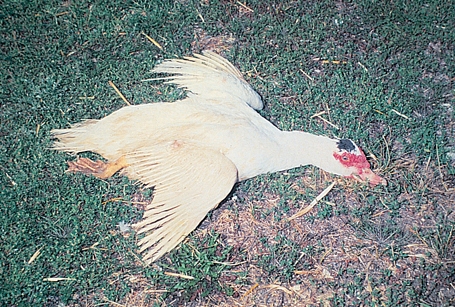Difference between revisions of "Avian Medicine Q&A 15"
| (2 intermediate revisions by the same user not shown) | |||
| Line 3: | Line 3: | ||
|- | |- | ||
| align="center" | [[File:Manson_logo.gif|90px|Mansonlogo]] | | align="center" | [[File:Manson_logo.gif|90px|Mansonlogo]] | ||
| − | | align="left" | This question was provided by [[:Category:Manson|Manson Publishing]] as part of the [[OVAL Project]]. See more [[ | + | | align="left" | This question was provided by [[:Category:Manson|Manson Publishing]] as part of the [[OVAL Project]]. See more [[Category: Avian Medicine Q&A|Avian Medicine questions]] |
|} | |} | ||
<br><br><br> | <br><br><br> | ||
| Line 29: | Line 29: | ||
Vaccination yearly with type C toxoid is helpful. | Vaccination yearly with type C toxoid is helpful. | ||
| − | |l3= Clostridium botulinum | + | |l3= Clostridium botulinum |
</FlashCard> | </FlashCard> | ||
| Line 36: | Line 36: | ||
desc none}} | desc none}} | ||
[[Category: Avian Medicine Q&A]] | [[Category: Avian Medicine Q&A]] | ||
| + | [[Category:To Do - Manson]] | ||
Revision as of 13:39, 29 June 2011
| This question was provided by Manson Publishing as part of the OVAL Project. See more |
During the summer a number of waterfowl have been found dead on the shore or ‘paralysed’ at a city park. The lake is shallow and heavily overgrown with foliage.
| Question | Answer | Article | |
| What is your preliminary diagnosis and how would you confirm it? | Avian botulism – limber neck; alkali duck disease – is diagnosed based on identification of Clostridium botulinum type C toxin, which does not affect mammals.
This toxin is most commonly found in maggots on carcasses. Serum toxin analysis or mouse innoculation neutralization tests confirm the diagnosis. Birds suffer an acute flaccid paralysis of the voluntary muscles, often occurring in mid swim, leading to death by drowning. |
Link to Article | |
| What conditions lead to this problem? | Outbreaks occur in hot weather, due to alkali and anaerobic conditions arising, often in stagnant water. As the water temperature rises, oxygen levels fall, the latter possibly being exacerbated by decaying organic matter in the water. Fish and invertebrate carcasses act as a substrate for clostridial spores and hence toxin production, the toxin may then become concentrated in maggots that are feeding on the carcass.
|
Link to Article | |
| What is the best treatment, control and prevention plan? | If the bird can still walk but not fly, good nursing and supportive care will often be effective.
If the bird can swim but not walk, the prognosis is not so good, but it may recover. Therapy involves oral fluids with activated charcoal and bismuth. Antitoxins are not proven to be effective and they are expensive. Control involves the removal of all carcasses from the water, as well as the removal of decaying vegetable material. The toxin is stable in water and the area of water will typically remain contaminated until the increased water flow caused by autumn storms, for example, washes the toxin away. Water flow and oxygenation should be improved if possible. Vaccination yearly with type C toxoid is helpful. |
Link to Article | |
